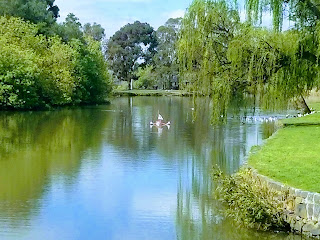I deviated a little bit from building tensegrities with hexastix, yet my knowledge of geometry helped a lot. I don't really know whether George Hart came up first with the idea to weave sticks (pencils) together in a double tetrahedral way, his sculpture
72 pencils usually pops up soon when researching them.
I found an
instructable how to build hexastix, but I didn't like the idea to build a jig first. Luckily, I managed to dig up a
cached copy of a different way to put it together, requiring just some rubber bands and patience.
As I still have an ample supply of sticks in various diameters and length, rubber bands aplenty and still some patience, I gave it my first shot.
 |
| First Hexastix |
While I was happy with the result, I didn't like the idea to douse the entire structure in glue to make it solid. The rubber bands keep each of the eight hexagonal opening together, but only two of corner of each hexagon aren't held in place by the weaving pattern. A bit of wood glue fixed the most critical ones, and while most sticks can slide around, the object can be handled with disintegrating.
Encouraged by the first success, I decided to bring more colour into it.
 |
| Four colour hexastix |
The colours emphasise the four intersecting axis of the object, but don't really make the double tetrahedral structure obvious. I haven't bothered yet to fix it with glue, so you see the rubber bands holding everything in place.
 |
| Level 4 hexastix |
I realised that the pattern could be easily extended, the level 4 hexastix has 102 instead of 78 sticks. By placing the longer sticks in a way they they only stick out on one side, the tetrahedral base structure becomes more obvious.
 |
| Skewer hexastix |
I did the bamboo skewer hexastix mainly to find out whether I still needed instructions, and realised that I finally understood the construction well enough to do it without any photographic help. Now I focussed more on having a pleasing relation of the core of the object to the extending hexagonal columns.
 |
| Level 5 hexastix |
The sticks in the Level 5 hexastix have only 2mm diameter, so to change the aforementioned relation I either had to use much shorter sticks, or expand it with more sticks. This object has 126 sticks, and after glueing the corner sticks into place I gave it a bit of a paint job for more aesthetic appeal.
 |
| 10 cm hexastix |
The last variant explores shorter sticks, going back to 78 sticks. It is still held in place by rubber bands, fixing only the sticks which need to be glued in place. I'm convinced that I build it exactly the same way as all prior version, but for some unknown reason I need only fix three of the four hexagonal columns. Five out of the six hexastix I build display the same pattern when looking towards the core, the last one has two different ones.
The geometry of the hexastix offered some surprises to me. It's basically a merkaba shape, two intersecting tetrahedra.















